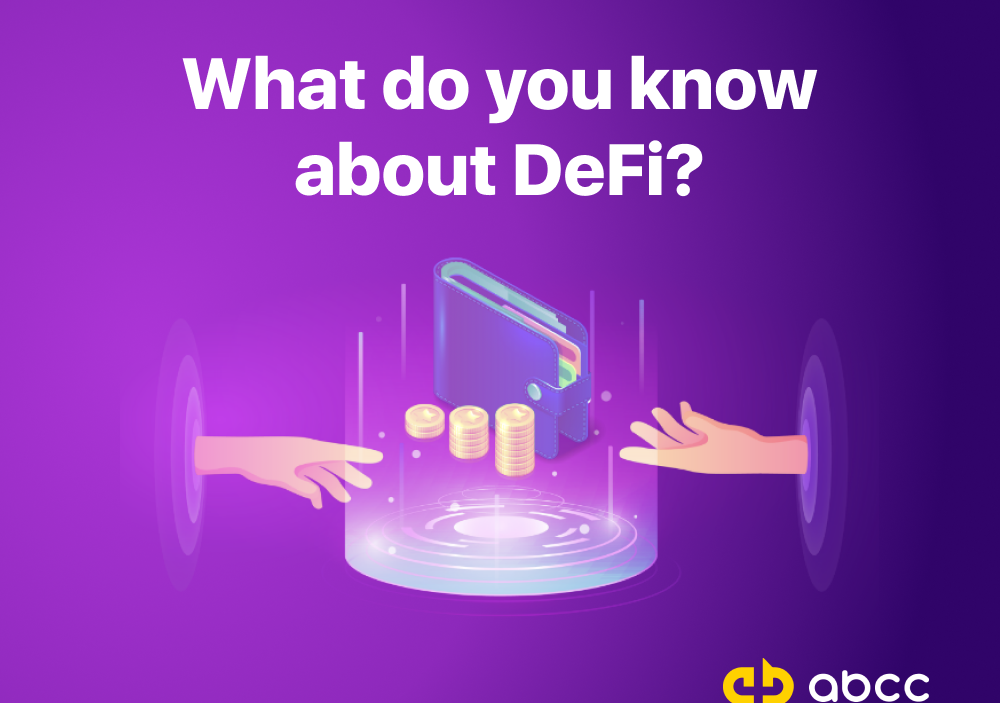DeFi (Decentralized Finance), or open finance, is probably the most revolutionary application of blockchains. It has impact on traditional finance and has the potential of changing the whole financial system. We can take DeFi as an automatic financial service provider like a bank.
What is different from an actual bank is that DeFi can benefit from the advantages of blockchains. With the technology of blockchains, users can truly control their own money and acquire all kinds of financial services such as borrowing, lending money, and exchanging crypto assets executed by “smart contracts”, without any intermediary. And all these operations done by a user will be permanently stored on the blockchain and cannot be changed.
We will go through some essentials and common features of DeFi as following:
- Native Coins on Blockchain
- Wallets
- DEX (Decentralized Exchanges)
- Lending and Borrowing
- Yield Farming
- The existing problems of DeFi
- Start trading DeFi tokens
Volatility
Twitter – https://twitter.com/ABCCExOfficial
Every blockchain has its own native coins or tokens for security purpose – to pay the trading fees on the blockchain to the miners. Miners will pack the transactions and upload them on the blockchains and these data will be permanently stored. Therefore, users must deposit native coins or tokens in their wallets ahead to pay for the transaction fees they’re going to operate. Herewith are some popular blockchain coins or tokens:
Wallets
Wallet is the first step entering the world of DeFi. Wallet can be view as crypto assets account viewer and password keeper on blockchains. Users can review their crypto assets on different blockchains. Many wallets now support multiple blockchains and can be easily shifted between blockchain networks.
Serve as a password keeper, wallet is also used to encrypt any traction operated by users. This encryption is like signatures in traditional finance, by signing on operation with user’s private key and can be verified by any validators on blockchain without any other personal information needed.
There are three kinds of blockchain wallets available now:
- Hot Wallets
- Mobile Wallets
- Browser Wallets
- Cold Wallets
Many blockchain wallets support different versions such as MetaMask and TrustWallet. Cold wallets are the safest way to store your crypto assets, however it is less used by users since they are relatively inconvenience.
DEX (Decentralized Exchanges)
DEXes are probably the first thing a user will try on blockchain. They are the decentralized version of crypto exchanges. Users can trade any existing trading pairs on DEXes. Different DEX protocols focus on different users’ needs.
Uniswap is known for its role in facilitating automated trading of DeFi tokens. That makes it easy for users to swap an ERC-20 token for another ERC-20 token without the need of an orderbook. This works using an Automated Market Maker (AMM) where Liquidity Providers (LP) deposit tokens into the smart contract and this liquidity then provides a price quote to traders.
Curve is known for stable coins that uses a modified AMM model specialized for stable coins trading. It aims to provide users involved in DeFi activities such as yield farming and liquidity mining, as well as those looking to maximize returns without risk by holding notionally non-volatile stable coins.
SushiSwap started as a fork of UniSwap, known as the largest decentralized exchange on Ethereum. However, SushiSwap aims to diversify the AMMs market and develop additional features beyond where Uniswap started, such as increased rewards for network participants via its native ERC20 token, SUSHI.
Lending and Borrowing
Another commonly used feature of DeFi (and in traditional finance as well) is lending / borrowing. Users with capital needs can borrow money from these protocols. while users with idle capital can borrow their money and earn profit from it. Borrowers have to notice the collateral ratio of each protocol. There are popular lending and borrowing protocols like MakerDAO, Aave, and Compound.
Yield Farming
Liquidity mining, part of “yield farming”, is another innovative feature of DeFi. The essence of liquidity mining is the process of making cryptocurrencies and tokens stay in the ecosystem to obtain more and more returns. Due to the participation of many investors, liquidity mining provides DeFi with a huge currency market and reduces volatility and transaction friction.
Liquidity mining usually starts with depositing cryptocurrencies or tokens in the “liquidity pool” of the protocol. For example, users need to create or contribute trading pairs such as ETH-wBTC. As liquidity is provided or assets are pledged, which contributes stability to the protocol, liquidity providers can be rewarded accordingly.
Besides part of the transaction fee of the transaction pair, the reward also includes LP Tokens, which proves that you have the funds, and can also be transferred, exchanged, or even mortgaged on other agreements in exchange for the original tokens of the agreement. The level of rewards given to liquidity market makers will depend on the amount of capital pools they own or control.
Most people generally use protocols such as SushiSwap or Aave when they come into contact with liquidity mining. With the continuous development of ecosystems, more and more advanced protocols have emerged. These agreements usually allow users to obtain LP tokens for mining by providing liquidity on DEX such as Uniswap or SushiSwap.
The existing problems of DeFi
Volatility
As one of the newest fields in digital finance, there is no doubt that DeFi also contains various potential risks. Like all other investments, the value of an investment may rise or fall, and you cannot guarantee 100% return. In addition, the prices of the assets you invest in will also fluctuate from time to time. This kind of price fluctuations are particularly dramatic in cryptocurrencies.
Rising of Gas fees
DeFi transaction fees known as gas fees are collected by developers on each blockchain, as the price of tokens increases, the cost of transactions also increases, which invariably compresses profits.
For example on the Ethereum blockchain, due to the increasing popularity of DeFi and the rising value of Ethereum, gas fees have also risen. For DeFi users with small capitals, the high gas fee puts investment at great risk. The proportion of this fee in total expenditure has risen sharply, compressing profits.
Lack of Liquidity
As cryptocurrency is a very new market and there are thousands of coins tokens exist and new to come every day, it is unlikely for market makers to maintain sufficient liquidity of all the trading pairs. Even with the invention of automatic market makers, users will still suffer from high slippage. This fact is painful especially for users while trading new, long-tail assets.
Start trading DeFi tokens with ABCC:
| Theme | Trading Pairs |
| Native Coins | ETH/USDT | ETH/USDC |
| Ethereum Scaling | MATIC/USDT | LRC/USDT |
| CrossChain | REEF/USDT | REN/USDT |
| Oracle | Index | LINK/USDT | GRT/USDT |
| DEX | SUSHI/USDT | CRV/USDT | UNI/USDT | BNT/USDT | ZRX/USDT | 1INCH/USDT |
| Lending and Borrowing | AAVE/USDT | COMP/USDT | MKR/USDT |
| Yield Farming | Derivatives | Asset Management | YFI/USDT | SNX/USDT | NMR/USDT |
| Payment | SXP/USDT |
Haven’t verified your account?
Verify account now and start trading!
Join ABCC Communities
Twitter – https://twitter.com/ABCCExOfficial
Telegram –
English: https://t.me/ABCCExOfficial_en
Russian: https://t.me/ABCCExOfficial_ru
Chinese: https://t.me/ABCCExOfficial_cn
Turkish: https://t.me/ABCCExOfficial_tr
Vietnamese: https://t.me/ABCCExOfficial_vn
Spanish: https://t.me/ABCCExOfficial_es
Italian: https://t.me/ABCCExOfficial_it
Indian: https://t.me/ABCCExOfficial_in
Portuguese: https://t.me/ABCCExOfficial_pt
Risk Warning:
You should be aware that cryptocurrencies are subject to high price-volatilities. You are solely responsible for determining whether any investment, investment strategy or related transaction is appropriate for you based on your personal investment objectives, financial circumstances and risk tolerance. ABCC reserves the right to rescind and terminate our services to users in countries and jurisdictions where relevant laws and regulations apply.




